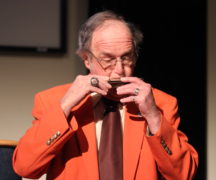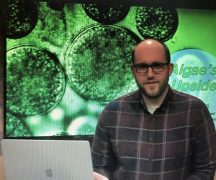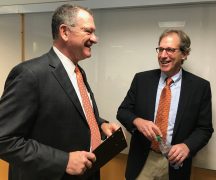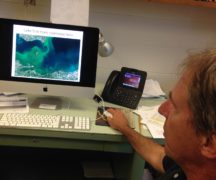By DAVID DUPONT
BG Independent News
Don’t expect an invitation to the fish fry anytime soon, but Kevin Neves and his colleagues at Bowling Green State University are hard at work figuring out how to grow the main dish, and even provide a salad on the side.
Neves, an assistant teaching professor in Marine Biology, presented a talk on aquaculture – “What do you mean there aren’t plenty of fish in the sea? That sounds fishy to me!” – as part of the Science Café series.
The series, as Professor Tim Davis explained in his introduction, is intended to present to the public in an informal setting the research being done on protecting the watersheds and Lake Erie. The pandemic has pushed the series to Zoom, at least through the spring, he said.
Neves has worked in aquaculture both in the lab and in the field for a number of years on the East Coast.
There he worked with salt water species. That’s not possible in the Midwest.
So, since 2017 he’s been studying growing yellow perch. This was a change for him because yellow perch is not highly thought of as a food source in the East, and yet here in the supermarket it fetches top dollar, more per pound than he could buy lobster in Maine.
The project set up in the greenhouse on campus doesn’t just cultivate perch. The idea is to create an integrated multi-trophic aquaculture system where more than one species is grown at the same time.
One species will exist to consume the waste products of the larger species. At first, he paired the perch with the fresh water prawns, which have commercial value. That didn’t work, he explained, because prawn are cannibalistic. Very few get very big by literally eating their young.
So, he switched to crayfish. These do not have much value as food, but are sought after as bait for smallmouth bass.
The water life is in a three-foot-deep tanks in the greenhouse – two tanks contain the perch and the third contains the crayfish. The water from those tanks is now packed with nutrients including phosphorus and nitrogen. It is pumped into a one-foot deep raceway where tomato plants are placed, nourished by the nutrient rich water. The water then is returned to the fish tanks.
The project experimented with various plants to grow, including jalapenos, bok choy, kale. Then Wes Radabaugh, a student working with Neves, suggested tomatoes. “The tomatoes took off,” Neves reported. They grew better than those grown in soil.
And then he worked with Jonathan Kershaw, in food science, and his graduate student Brittany Kralik to see how well the fish and tomatoes produced by the system will be accepted by consumers.
So far the tomatoes are stacking up very well against what’s available at Kroger. Sweeter, saltier, juicier, less bitter.
Later an attendee suggested that a truer test may be how they measure up against what’s available at a farmers market.
That aspect has been not tested in part because of the pandemic, Neves said.
Neves and his collaborators, both faculty and students, have been working with researchers, led by Silvia Newell of Wright State, to study the balance within the system.
If there are too many fish, the plants cannot absorb the waste materials, especially ammonia. If the system has too many plants, however, they would not thrive because the fish would not produce enough nutrient rich waste.
By determining the right balance, they could arrive at a formula that would lead to the development of “plug-and-play” systems that could be used by producers and backyard hobbyists.
At this point it’s hard to calculate the cost of the process. The greenhouse was built in the late 1960s, and has an inefficient heating system and outdated ventilation.
Also, a major expense is food for the fish, Neves said. But in the future other more sustainable options could be developed. One would be to use by-products from agriculture. Another, which would address another major environmental threat to the Great Lake, would be to harvest Asian carp.
Neves and his colleagues are also investigating how to use aquaculture to address the problem of harmful algae blooms in Lake Erie.
The system would take water runoff from fam fields that contains the phosphorus and nitrogen that feeds those algae blooms and instead use it to grow algae that can be fed to tilapia. Those fish are valuable for pond management. The waste from the tilapia can nourish crayfish with the water from the crayfish tanks then used to grow another crop, such as lettuce.
Now the farmer could mitigate the runoff of nitrogen and phosphorus, and gain saleable products.
With a grant from the USDA and National Science Foundation, Neves will be constructing a greenhouse at the Ag Incubator property on Middleton Pike to see if test and refine such a system.
BGSU’s efforts come at a time when more and more of the fish humans eat are produced through aquaculture. The systems can be in closed systems like these, or ponds, or netted pens in the ocean.
The demand, he said, is growing as the world’s population increases and an increasing percentage of those people are eating fish.
As of 2018, more of the fish people eat now come from aquaculture. This is important because many species of fish are now at unsustainable levels, and very few species are underfished.
“Aquaculture is the fastest growing sector of food production,” Neves said.
China is the largest producer – it produces more than twice as much as the rest of the world combined. The United States, Neves noted, is the 16th largest producer and one of the few places where production is edging downward.
The industry, Neves said, has been controversial. Like conventional land farming it can produce excess nutrients. That was seen in fjord pens growing salmon in Norway.
The farmed fish also can transmit diseases to other species. And the antibiotics used to treat diseases in farmed fish pose health issues. Also, the farmed species can escape and threaten native fish.
Much of aquaculture, Neves said, is focused on growing one target species. This also creates an economic threat if something goes wrong that impacts just that one species, everything is lost.
Because of these problems, many people have negative attitudes toward aquaculture.
These are the kind of issues an integrated multi-trophic aquaculture system like those Neves is working on are intended to address.
It’s possible that coming up with a sustainable system could help people overcome their negative perceptions of the industry.
Kershaw, the food scientist, said the products could appeal to consumers who are interested not just in food that tastes good, but also in food that’s grown locally and in a sustainable way.





